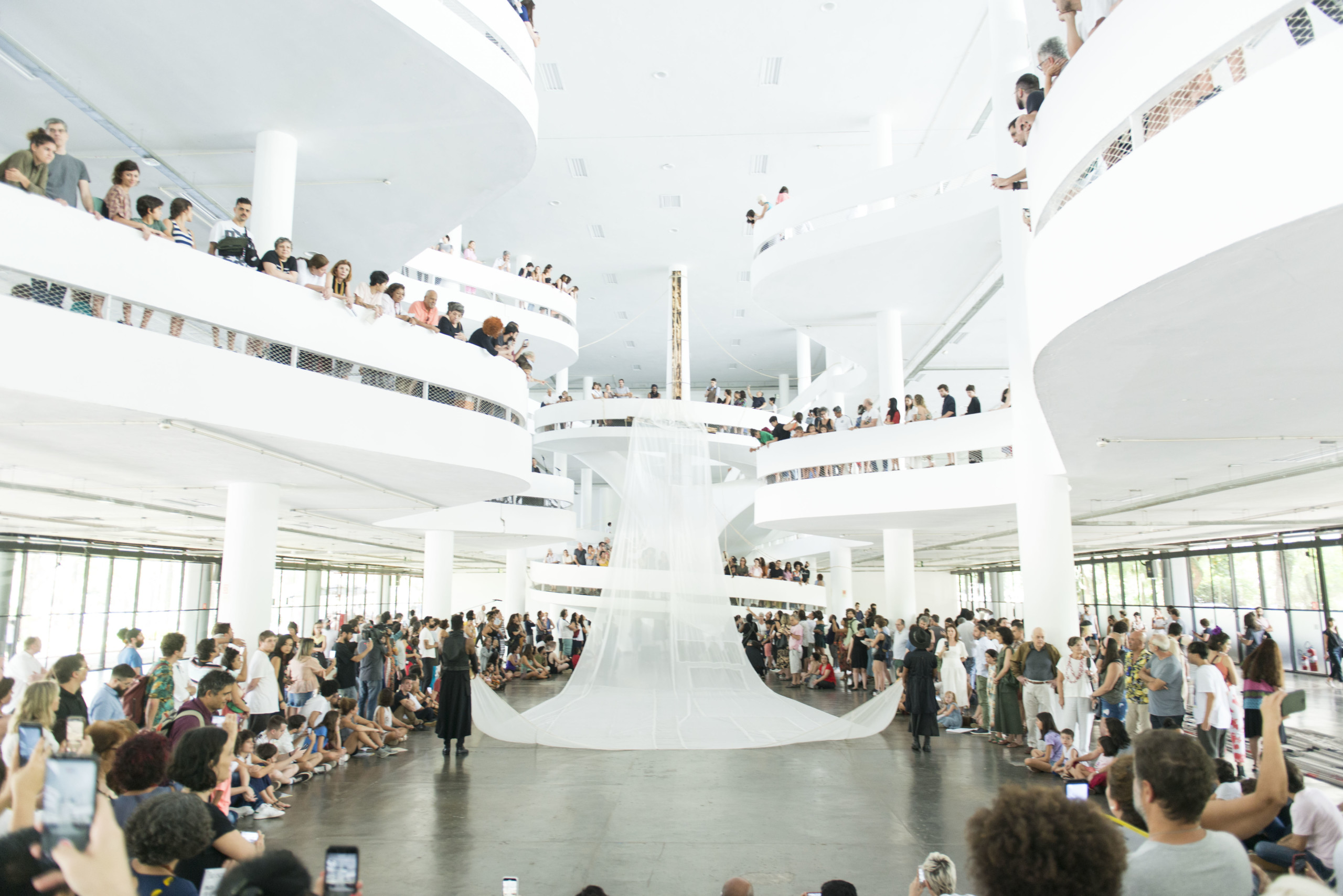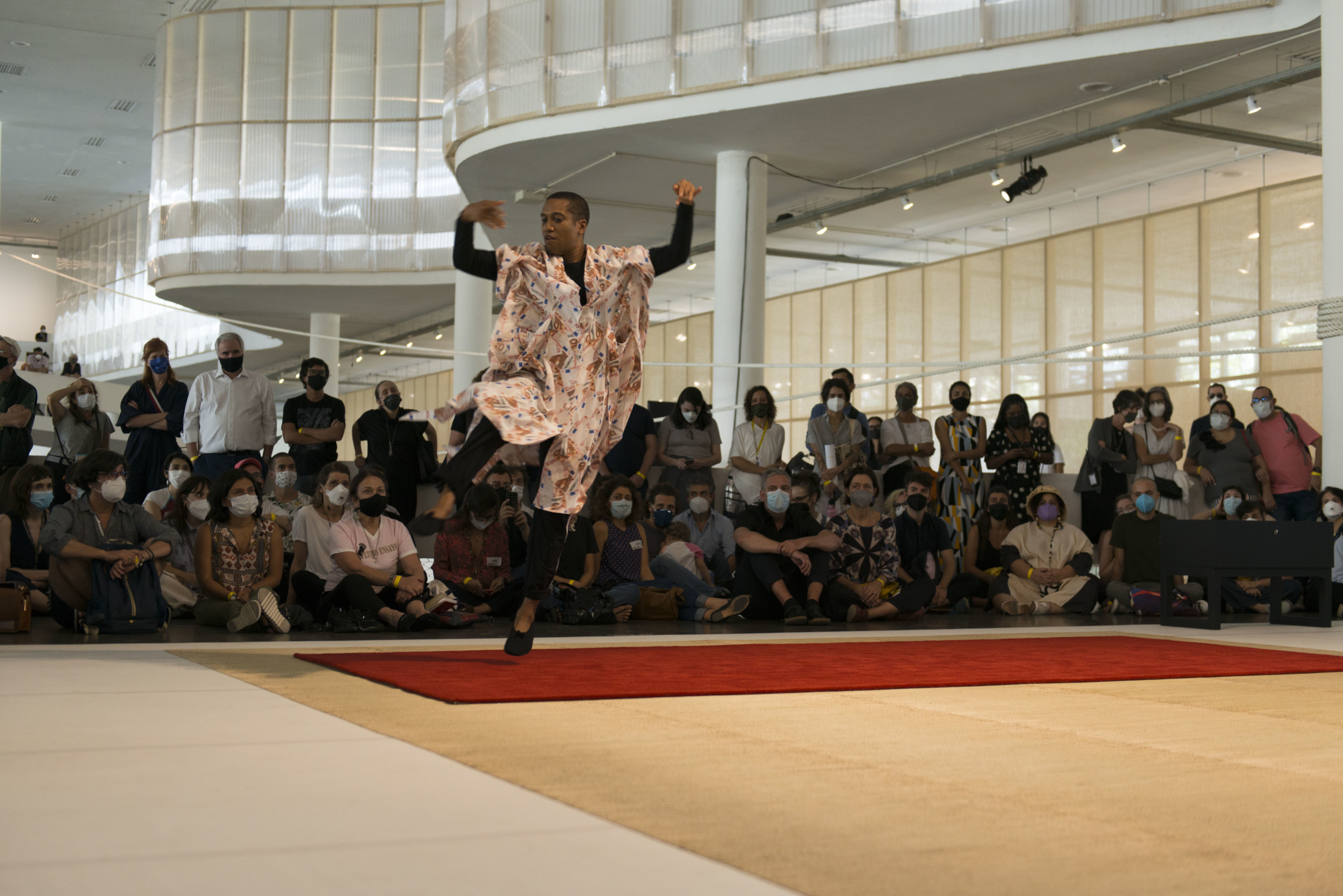
Titled after Madrugada Camponesa (1962) by Thiago de Mello, this year’s São Paulo Bienal draws on the past and present social-political tensions of Brazil and inspires a conversation on what it means to actively listen in 2021. Although Ruth Estevez has been busy this year as the new director of Brooklyn’s Amant, she spent the last three years contributing her knowledge of performance and theater to the curatorial team of the 34th edition of the São Paulo Bienal. We spoke candidly about what this moment in art history means to someone curating the longest-running exhibition in Latin America.
June Canedo de Souza: What key words or phrases describe your intentions for this Bienal’s curatorial process?
Ruth Estevez: The curatorial process was quite unusual for me; however, it opened the door to a truly collaborative project. Rather than come up with a specific topic or theme, we had a series of workshops in which each member of the curatorial team (Carla Zaccagnini, Francesco Stocchi, Jacopo Crivelli and Paulo Miyada) brought names of artists and writers we thought were relevant and socially engaged with the time we live in. We were intentional in thinking about what is currently happening in Brazil and what the people of Brazil are living through.
At the beginning, we refused to identify the groups we had created under specific words or theoretical concepts, but wanted to let the works speak by themselves, complementing and contradicting one another. This edition of the São Paulo Bienal relied on memory as a way to acknowledge the brutality of the present. Our aim was to identify connections between different moments in history to understand how art has been a tool of resistance in turbulent and violent times.

JCdS: Can you talk me through the texts displayed throughout the pavilion?
RE: We developed a series of statements that introduce the different groups of artworks: These statements are stories that accompany objects, situations, images and documents that depict specific events and moments in history. Using the premise outlined by the Martinican poet Edouard Glissant, in which relation is more significant than equivalence, we wanted to emphasize the right to opacity against colonialism's brutal demand for transparency—the notion that you can only accept someone if you fully understand his subjectivity. Historical colonial ideologies have been built on ideas that signify originality, superiority, etc. In this Bienal, Indigenous Brazilian artists played a crucial role not only in demonstrating their struggles through their work but also in disrupting dominant ideas.

JCdS: Is the bell of Tiradentes another artifact meant to speak to this theme of resistance?
RE: Yes, it is. The Capella de Nossa Senhora do Rosário dos Homens Brancos is a small church in Ouro Preto in Minas Gerais, Brazil. On April 21 of 1872, this bell was the only one that rang for the execution of Tiradentes, a revolutionary who was involved in the Minas Gerais Conspiracy against the Portuguese. In the years following the independence of Brazil, Tiradentes would become a hero and the bell a symbol of the struggle for the country's sovereignty. In 1960, the bell traveled to Brasília for the inauguration of the new capital. We wanted to bring this bell to the São Paulo Bienal as a reminder of history at a time when the current government would like their citizens to ignore the past. Sadly, we didn't manage to bring the bell but displayed a video of it tolling instead.
Some other statements include a series of objects that survived the fire of the National History Museum of Rio de Janeiro in 2018, where thousands of cultural artifacts were destroyed, in part because of the precarious condition of the museum. We included letters written by Joel Rufino Dos Santos, a writer and educator to his son (while he was imprisoned for his ideas during the dictatorship), some ceramics from the so-called Cerâmica Paulista that, contrary to what has been said in history, were made by the women of the Tupiniquim community through an exchange with the Portuguese colonizers as a way of preserving their own identity. As you see, the statements evoke resistance, invisibility, repetition, survival, opposition and relation in different ways.
JCdS: Could you speak about the title of the Bienal?
RE: The title is another statement within the Bienal and appears throughout the exhibition as a way of grouping works together. It’s based on Thiago de Mello's poem Madrugada Camponesa [Peasant Dawn], that he composed in 1962, a time of hope for Brazil in a moment when the country was trying to reform education, access to land and housing for all. The last two lines of this poem are: “Faz escuro mas eu canto/ porque a manhã vai chegar” [Though it’s dark, still I sing/ because the morning is coming].
Just a few years later, most of those dreams were shattered by the coup d’état that culminated in a long and cruel dictatorship. This sentence was used as a title of a song on the record album Manhã de Liberdade [Morning of Freedom] by singer Nara Leão, one of the key voices of a generation that took the risk to speak and sing about the freedom of critical thought in times of political narrowing.
It’s also a poem by German playwright Bertolt Brecht, which reads, “In the dark times/ Will there also be singing?/ Yes, there will also be singing./ About the dark times.” Even though both poems mention singing during turbulent times, in Thiago de Mello's poem there is still a possibility of singing about hope, especially for those in danger and whose ideas and bodies are harmed by political projects that seek to eradicate them.

JCdS: I saw a lot of work that could have either been directly or in conversation with social practice. Was this a theme in this year’s Bienal?
RE: More than social practices, I think you can find artists that work in collectivity or that understand the result of their work as a representation of a collective effort. Just to give you an example, we invited Sueli Maxakali, who is a leader of the Tikmũ’ũn indigenous people, better known as the Maxakali. Forced to leave their ancestral land to survive the aggressions that accumulated over the centuries to the point of leaving them at risk of extinction in the 1940s, the Tikmũ’ũn have maintained their language and culture. For the 34th Bienal, the artist presents the installation Kūmxop Koxuk Yõg [The Spirits of My Daughters], a collection of objects, masks and dresses that refer to the mythical universe of the Yãmĩyhex—spirit women. All the work for the exhibition was made with women and girls in the community who take care of each one of these Yãmîy spirits. The collective process of creating the work is coherent with the organization of the Tikmũ’ũn community itself, and in a sense stretches and shakes up the meaning, limits and relevance of artistic production in such a specific context, presenting us with other regimes of authorship and creativity.
JCdS: Can you talk me through what “this moment” means to you?
RE: We really wanted to create a voice that would resonate through the relationship between the works and the statements. It's for this reason that the statements are more about telling a story than supporting a theory. As companions of the artists, we learned to listen and allow narratives and concepts to grow freely as they are based on people's memories and imaginations. We are in a moment where curators need to give a voice to those who have not had the chance to tell their own stories, ideas, contexts, etc. This is a time for listening. I tried to select projects that could explain the relation between theater, performance and the history of social protest and activism.
JCdS: I feel that performance is always the medium that propels political movements forward and to create language around them.
RE: In recent years, museums have used performance as a dialogical tool to engage with the public because of the use of the body. We are living through difficult times, and performance has been negatively affected. I understand that during COVID-19 it's difficult to think about live art, but we should create strategies that allow performance artists to survive and develop their practices.

JCdS: What were you were reading while curating this Bienal?
Ruth: Over the past three years, I have re-read books that have played a significant role in my education and career. On the one hand, I was reading Glissant, especially the Poetics of Relation. Additionally, I was reading several books about collective theater in Latin America by writers such as Enrique Bonaventura, Augusto Boal's The Theatre of the Oppressed, and, finally, I remember reading the poetry of Jayne Cortez (we are preparing an exhibition on her work for Amant). The Bienal does not include Jayne's poems, but her lines about police brutality against people of color seem as timely as ever.
My work is heavily influenced by poetry, literature and theater, and it is the same for this biennial. In times of change and disruption, the literary imagination is capable of rearranging and reorganizing time and space, while thinking about the past, as well as imagining many different futures. Storytelling has always had the ability of combining the experimental with the vernacular.
JCdS: What you will bring home from this experience?
RE: Many of the artists with whom I worked at the Bienal will also participate in the Amant program. The Bienal provided me with the opportunity to learn, to engage in many studio visits and to conduct research around the world. I would like to take advantage of this incredible number of new resources.
We have a wonderful artistic and institutional scene in the United States, but sometimes we are too focused on our own problems and fail to realize that these issues also exist in other contexts. It has always been important to me to create awareness and to understand history from other perspectives. I received this quote about Glissant from my friend Manthia Diawara the other day, and I think it's a good way to end this interview: "Let us not close ourselves to the world; let us not surround our suffering within impenetrable barriers; let us use our different locations to think with the world, to change the world."
Craving more culture? Sign up to receive the Cultured newsletter, a biweekly guide to what’s new and what’s next in art, architecture, design and more.










 in your life?
in your life?

